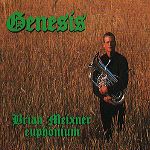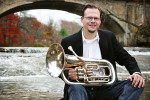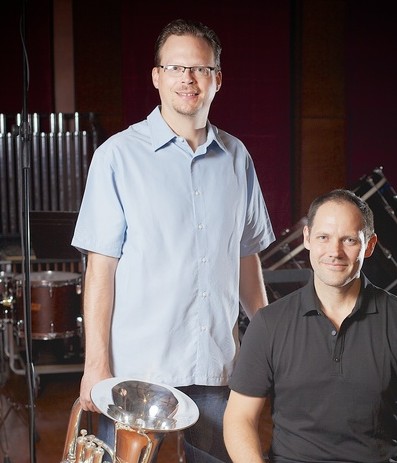What is there to do as a euphonium major, really? Maybe you could ask Brian Meixner, after finishing a doctorate at the University of North Texas as a teaching assistant for Brian Bowman, Meixner landed as euphonium player, soloist and assistant conductor of the River City Brass Band, recorded a solo CD launched and recorded with The River Bottom Quartet. Meixner has commssioned his share of new works, and a passion for new music seems to have led him to the formation of the expansive duo, Praxis, with percussionist and composer Nathan Daughtrey. While many would stop to breathe, Meixner has just taken flight! Accepting a new position as director of the North Carolina Brass Band, he blends his euphonium and chamber careers into conducting and teaching. The question for this euphonium player shouldn’t be what, but rather; what’s next? The Fourth Valve takes flight! Enjoy…..
1. Praxis reveals the use of a wide palette of colors from your euphonium, from the diffuse warmth of conical to the focused brilliance of cylindrical. What techniques and pedagogical controls do you use to achieve such a wide spate of colors from a single instrument?I am glad to know that these varying tone colors have come across to the listener! The most basic answer to this question is that I have in my ear the sound I want to produce and I work with the resistance of the instrument to achieve it. My thought on tone production on a brass instrument… it is achieved through a balance of air flow intensity versus resistance, colored by manipulation of the vowel. Each register of the instrument (each individual pitch, actually) has a different resistance (some instruments more than others). With a proper command of the air flow, knowledge of how the instrument will respond on any given pitch, and careful control of the vowel placement, one can produce a wide spectrum of colors throughout the range. I find the resistance inherent in the euphonium to be helpful in this regard and am amazed by the great trombonists I hear who perform with a tremendous variety of tone color without that aid of the resistance. In the end, I believe it is vital for the player to have clearly in their mind at all times the sound they want to convey to the audience.2. In an orchestra, percussion is often accompaniment and support, in wind symphonies it quite often becomes more of a significant color alternative to winds, while taking over some of the more repetitive figures less conducive to winds-brass in particular. How do you view the role of percussion in the brass band setting, by contrast?It is interesting to note that percussion instruments played a very small role in the early days of brass banding and were not even allowed to be used in competitions for several years in the early twentieth century. Percussion has, of course, become a much more integral part of brass band writing. Many modern brass band composers write extensively for percussion and I welcome it!
The role of percussion in brass band, as I see it, is similar to what you have described in orchestras and wind ensembles. However, in addition to percussion the orchestra uses strings, woodwinds and brass… the wind ensemble uses woodwinds and brass. The brass band uses only brass instruments, so it is not as sonically diverse as these other large symphonic ensembles. Brass band range stretches from the BBb tuba to the Eb soprano cornet and nearly every gap in that spectrum is filled by other brass instruments, but that spectrum does not include to other timbres present in orchestra and wind band. The complementing of this range by percussion is more important in brass band, I would argue, than that of the orchestra or wind ensemble due to the smaller variety of instruments and lesser amount of timbres. The added colors, brilliance and emphasis provided by the percussion section are essential, I believe, to the overall sound of the brass band.
What attracted you to percussion in chamber music, and what have you found?
I was initially exposed to this by the Brian Bowman/Gordon Stout recording of Samuel Adler’s “Four Dialoguesâ€ for euphonium and marimba. I suppose I was attracted to the sound of the two instruments playing together and liked the idea of doing something different than solo pieces with piano. Several years later I joined a consortium to commission David Cutler for a euphonium piece with cahon and maracas. During that same time I was working with a couple of other composers on pieces for euphonium with percussion ensemble. Partly due their great writing, but likely equally due to the interesting combination of instruments/sounds, I was turned on to euphonium/percussion music from that point forward.
for euphonium and marimba. I suppose I was attracted to the sound of the two instruments playing together and liked the idea of doing something different than solo pieces with piano. Several years later I joined a consortium to commission David Cutler for a euphonium piece with cahon and maracas. During that same time I was working with a couple of other composers on pieces for euphonium with percussion ensemble. Partly due their great writing, but likely equally due to the interesting combination of instruments/sounds, I was turned on to euphonium/percussion music from that point forward.
Simply put, the more variety of percussion instruments that are used, the more sounds that are capable, the more interesting for the listener and performer alike. With percussion, the number of timbres, sounds, etc. possible is literally limitless. This allows me to be more creative with the sounds/colors I can produce on my instrument and the musical interest for all involved. In the case of our Euphonium + Percussion duo and our album ‘Praxis’, it doesn’t hurt to have the opportunity to work with the mega-talent virtuoso percussionist and composer Nathan Daughtrey!
3. Has Praxis inspired you to reflect on the musical relationship that is the duo? How would you compare the musicians role in a duo with their role in a quartet or quintet?
I had not necessarily reflected on the duo in particular, however I will say that I have found great enjoyment working with Nathan Daughtrey specifically. We work well together in both rehearsal and performance settings, so my opinion of the duo may be biased to the positive simply due to that. I will say that with only one other person in my chamber group, it is much easier to schedule rehearsal time!
The importance of working together is similar to other chamber settings. Musical compromise and equal sharing of ideas is no different, but I suppose there is more responsibility per member when the numbers are reduced.
In working with a percussionist, the intonation is solely my responsibility, as the percussionist is not able to manipulate pitch on the vast majority of instruments (much like performing with piano). I find that to be an advantage, actually, as it is one less variable in performance! I know I am getting consistent pitch from my colleague each time we get together, so the intonation is predictable – big advantage.
4. Who are your low brass playing heroes? Do you find any special resonance with the life of Leonard Falcone?
My biggest low brass playing hero is my graduate school teacher and mentor, Dr. Brian Bowman. I say this not only because of his virtuosic playing and life-changing teaching, but also due to him being one of the greatest pioneers and innovators on my instrument. Adding to my tremendous respect for him is his selfless approach to his career as a teacher and performer. What I have witnessed from Dr. Bowman is an approach to life through service to others. I am sure that all of us who know him would share a similar observation. Choosing to do my graduate studies with him at UNT was probably the best decision I have made in my professional life.
Countless other players on all three low brass instruments have been inspiring to me, including several artists from my generation and younger. Due to my hybrid career as a performer/conductor, I am particularly inspired by my colleagues and mentors who are successful at both. A prime example is Demondrae Thurman. Difficult to continue naming folks, as I will inadvertently leave some off the list!
How could any euphonium player reflect on the life of Leonard Falcone and not find at least some resonance! He was a true pioneer and all euphonium professionals have he and others to thank for any successes we may have in our profession. Mr. Falcone was, of course, an influential teacher and conductor as well as a performer, so I find great inspiration in his accomplishments from all aspects of his career.
 5. What is your warm up like now as opposed to grad school?
5. What is your warm up like now as opposed to grad school?
Similar, but has evolved some due to new ideas I have been exposed to and needs that have arisen in my playing, etc. I still use the basic set of exercises taught to me by my teachers Brian Bowman, Skip Gray and Hugo Magliocco, but I do not have as much time each day to do a solid hour or two of “warm upâ€/fundamental exercises as I did when I was in grad school. A full-time teaching job, running my own business and helping my wife raise two children under the age of five cuts down on warm up time! That being said, I have found that neglecting to address certain fundamentals in my playing on a daily basis will cause a noticeable decline in my playing, primarily (for me) tone and articulation. When warm up time is limited, I rely on the early exercises in “Lip Flexibilities for All Brass Instruments†by Bai Lin, the combining of long tones and slow lip slurs. These allow me to do some long tone work while focusing on the clean/pure transfer of sound across harmonics. Also various flow studies (ex. Cichowicz/Brass Gym) to ensure purity/consistency of sound through various interval patterns. Repeating these exercises using articulation combinations allows me to cover the most basic foundation of playing my instrument in a short amount of time at the beginning of my day.
I also include at least some low register lyrical playing each day. If I am able to play with smooth connection and rich sound below the bass clef staff, then I have the command and control of the air flow needed to be effective in any range of the instrument. If time allows, I expand the warm up/fundamentals from there to address specific aspects of my playing that are needed for the solo/ensemble work I am doing at the time.
6. Which came first for you, inspiration to conduct or opportunity (necessity)?I have always aspired to be a conductor in some capacity since I chose music as a career. My path as a conductor was formed out of a career as a professional performer, which I have found to be a beneficial route for many reasons. I have been very fortunate to study with some truly fantastic musicians and teachers, who formed me not only as a player, but more importantly as a musician. I think most players want to work under a conductor who is a competent and accomplished musician, which I hope I can say about myself.
I thoroughly enjoy my work as a conductor. I love being with people and there is certainly ample opportunity for that when working with an ensemble. I also find it to be musically rewarding to work with so many different instruments/sounds in molding a musical product, as aspect that is a bit limiting as a soloist. Also, a typical day at work for me includes practicing/playing euphonium and trombone, score study, teaching a few private lessons, then leading an ensemble rehearsal. This variety in my work day keeps me energized and motivated!
7. How does jazz inform your conducting and playing? Any thoughts on Rich Matteson, Bob Brookmeyer, Juan Tizol or more recent tenor-valve players?I do not have a lot of experience in jazz, however the training I did receive has been an invaluable resource as both a conductor and performer. It is hard for me to imagine success as a musician without being at least somewhat informed in jazz. The players you list are incredible musicians and artists, each of whom has helped shed light on the capabilities of our instruments. An innovator on the scene today who I believe deserves special mention is Ryan McGeorge, an extremely creative euphonium artist who is broadening our understanding of what is possible on the instrument. His playing, composing/arranging and recordings are all amazing.
8. What are your favorite chamber music works that include euphonium? Are there any other directions you would like to see explored?My opinions here are heavily influenced by my personal experience with certain pieces, having performed them with good friends and colleagues. The works with percussion I recorded with Nathan Daughtrey are among my favorites, as well as Gillingham’s “Diversive Elementsâ€, which I have performed a number of times with different friends and colleagues. The compositions and arrangements for euphonium quartet (and three euphoniums + 1 tuba) on our River Bottom Quartet album “In Too Deep†were a lot of fun. I also very much enjoy the music of Fernando Deddos, including the title track of the ‘Praxis’ album and his “Invasions and Myths†for euphonium, trumpet and piano that I recorded with Jennifer Dearden and Kevin Dill in 2015.
As far as directions for further exploration, I am thrilled to see the creative new works emerging for euphonium in a chamber setting. Lots of great stuff! It would be interesting to see more pieces for euphonium with strings, which seems to be somewhat of an untapped genre. The “Concerto No. 3 – Diran†by Alan Hovhaness is quite nice.
 9. How did the journey begin to bring a professional brass band to North Carolina?I accepted a music faculty position at High Point University and moved to North Carolina in 2012. During that first year I began talking to many of the top brass players in the Triad area (Greensboro, Winston-Salem, High Point) about the possibility of forming a professional-caliber brass band. The musicians were receptive to the idea and it became clear that a nucleus of a fine brass band was on board to get things started.
9. How did the journey begin to bring a professional brass band to North Carolina?I accepted a music faculty position at High Point University and moved to North Carolina in 2012. During that first year I began talking to many of the top brass players in the Triad area (Greensboro, Winston-Salem, High Point) about the possibility of forming a professional-caliber brass band. The musicians were receptive to the idea and it became clear that a nucleus of a fine brass band was on board to get things started.
The Triad population and economy appeared strong enough to support a new arts organization, so we went forward with establishing the North Carolina Brass Band. My business plan was to start with an attractive website and an exceptional product. The product was our debut album “First in Flightâ€. We raised start-up funds to get the business off the ground and were fortunate enough to receive enough donations to pay for the recording of the album.
The recording sessions for “First in Flight†were the very first time the band sat down together. The ensemble blended quickly, the recording sessions were successful and the album has since received high praise. Of course, none of it would have been possible without the players generously agreeing to do the recording for no pay. The willingness of these musicians to “buy in†to the vision of the organization was crucial, and the commitment from everyone involved (28 musicians and several Board members) was inspiring. With the product in hand and essentially no funds spent by the band, we were well positioned to move forward. The band played its first concert series in 2014 and has performed regularly since that point. We are now in year two as an organization and the musicians are paid per service. The band has performed several concerts locally in the Triad and in other locations in North Carolina. We are excited to be the featured brass band at the 2016 Great American Brass Band Festival, a tremendous honor for us! The NCBB is recording its second album, “Christmas Wrapped in Brassâ€, in January 2016.
c. 2016 David Brubeck All Rights Reserved. www.davidbrubeck.com
Interested in more “Fourth Valve” euphonium interviews? Check out these:
Demondrae Thurman 2015Jamie Lipton 2015Lance LaDuke 2015Matthew Murchison 2015Koichiro Suzuki 2015.Marc Dickman 2015Lauren Curran 2015Mitsusu Saito 2015Adam Frey 2015Martin Cochran 2015



